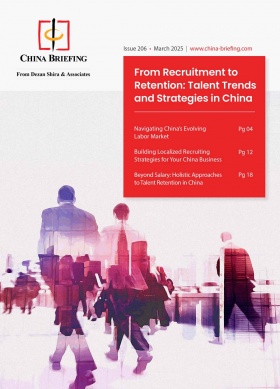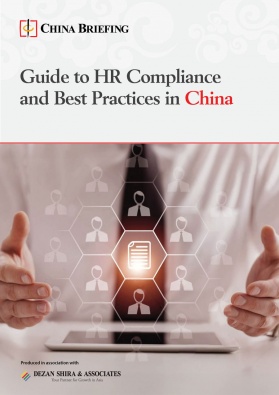China Labor Compliance in Hot Weather: What Foreign Companies Need to Know
China labor compliance amid extreme heat is a growing concern for foreign-invested enterprises. As temperatures rise across the country, so does regulatory scrutiny. This guide outlines key legal obligations, local policy variations, and practical recommendations to help foreign-invested enterprises (FIEs) manage heat-related labor risks while aligning with global standards.
During China’s peak summer months, prolonged heat waves across many regions pose serious health risks to outdoor and high-temperature workplace employees. For FIEs operating in China, ensuring compliance with local heat-related labor protection regulations—while aligning with global management standards and maintaining a positive employee experience—has become a critical compliance and operational challenge.
China’s regulatory approach to labor protections during extreme heat is becoming increasingly stringent, combining mandatory national rules with region-specific flexibility. Foreign companies unfamiliar with local nuances—such as the requirement to provide high-temperature allowances or differing regional standards—risk labor inspection penalties and potential disputes with employees.
This article provides a practical and concise compliance guide for FIEs to navigate China’s high-temperature labor policies. It highlights key legal obligations, local implementation differences, and best practices to help foreign companies build a compliant, risk-mitigated, and employee-friendly summer workplace management system.
Regulatory framework for high-temperature labor protection in China
China began developing its high-temperature labor protection system in the 1990s to safeguard employee health and workplace safety. A key milestone came in 2012 with the release of the Administrative Measures for Heatstroke Prevention and Cooling Measures (hereinafter, the Measures), which set nationwide standards for high-temperature allowance payments and workplace protections. This regulation, issued as a departmental rule, remains the primary national policy basis for high-temperature labor compliance.
In addition to this regulation, several core laws impose legal obligations on employers:
- Article 54 of the Labor Law requires employers to provide working conditions that meet national occupational health and safety standards. and
- The Work Safety Law further mandates that companies establish and maintain a sound system for ensuring labor safety.
Together, these laws and regulations mean that providing adequate protection for employees working under high-temperature conditions is not just a matter of employee welfare—it is a binding legal compliance requirement.
In practice, FIEs in China should pay close attention to the following key compliance areas during periods of extreme heat:
- Payment of high-temperature allowances according to local standards and in cash.
- Adjustment of work schedules to reduce outdoor or heat-exposed work during peak temperature hours.
- Provision of cooling facilities and personal protective equipment where applicable.
- Enhanced health and safety training specific to summer working conditions.
- Recordkeeping and internal documentation to support compliance during inspections.
Below, we will explore each of these obligations in detail.
High-temperature work protection measures
China’s regulatory framework imposes specific obligations on employers to mitigate the health risks associated with high-temperature operations. According to Article 7 of the relevant provisions, employers must implement the following occupational protection measures:
- Adoption of heat-reducing technologies: Employers are required to prioritize the use of new technologies, processes, materials, and equipment that help control or eliminate heat hazards at the source. Where complete elimination is not feasible, integrated control measures must be adopted to ensure compliance with national occupational health standards.
- Occupational health compliance in project design: For construction projects involving high-temperature occupational hazards, designs must conform to relevant national standards and hygiene requirements. Heat protection facilities must be designed, constructed, and commissioned in parallel with the main project infrastructure.
- Monitoring and risk assessment: Employers with high-temperature hazard operations must implement routine monitoring led by designated personnel. They are also obligated to conduct hazard factor testing and occupational risk assessments in accordance with regulatory requirements.
- Health examinations and recordkeeping: Employers must provide pre-employment, on-the-job, and exit occupational health examinations for workers exposed to heat hazards. Examination results must be archived in occupational health monitoring records and communicated in writing to the workers. All related costs are to be borne by the employer.
- Protection of vulnerable groups: Employers are prohibited from assigning pregnant employees and underage workers to any high-temperature operations classified at Level 3 or above under the national standard GBZ/T229.3: Classification of occupational hazards in the workplace – Part 3: High temperature.
These requirements underscore the principle of prevention-first in China’s approach to occupational health, emphasizing both engineering controls and administrative safeguards.
Adjustment or suspension of work during extreme heat
Employers are required to adopt appropriate measures to adjust work schedules or suspend work during periods of high temperatures to protect workers’ health. These include shortening outdoor work hours, reducing labor intensity, rotating shifts, and increasing rest time in hot environments. Key regulatory provisions include:
Temperature-based work adjustments: Employers must follow daily temperature forecasts issued by local or higher-level meteorological authorities to determine work arrangements.
- When the maximum daily temperature reaches 40°C or above, all outdoor work must be suspended.
- When the maximum temperature is between 37°C and 40°C, outdoor work hours must not exceed six hours per day, and no outdoor work is allowed during the hottest three hours of the day. Continuous work must comply with national limits. and
- When the temperature is between 35°C and 37°C, employers must implement shift rotations or other measures to reduce continuous work duration, and no overtime may be arranged for outdoor workers.
To be noted, employers may not deduct or reduce wages due to work suspension or reduced hours resulting from high temperatures.
Pre-summer health checks and job adjustments: Before high-temperature weather begins, employers must arrange health checks for workers engaged in hot environments. Workers with cardiovascular, pulmonary, neurological conditions, tuberculosis, or other health issues unsuitable for high-temperature exposure must be reassigned. The cost of these occupational health checks is borne by the employer.
Special protections for vulnerable groups: Employers are prohibited from assigning pregnant employees or underage workers to outdoor work when temperatures exceed 35°C, or to indoor workplaces where temperatures exceed 33°C.
High-temperature allowance
Under Article 17 of the Measures, workers engaged in high-temperature operations are entitled by law to receive a post-specific allowance. Employers must provide a high-temperature allowance to employees who are:
- Assigned to outdoor work in temperatures exceeding 35°C; or
- Working in indoor environments where effective measures cannot reduce the temperature below 33°C.
This allowance must be included in the total wage calculation and cannot be substituted with in-kind benefits. The specific allowance standards are formulated by provincial-level human resources and social security authorities, in coordination with other relevant departments, and are subject to periodic adjustments in line with economic conditions.
The conditions for receiving high-temperature allowances vary by city. For example, in some cities, such as Shanghai and Suzhou, employees are entitled to the allowance as long as they are assigned to outdoor work during the designated months, regardless of the actual temperature.
Heat protection supplies and training
Employers are obligated to ensure adequate protective support for workers exposed to high temperatures, as outlined in Articles 9 through 11 of the Measures. Key requirements include:
- Provision of protective equipment: Employers must supply compliant personal protective equipment (PPE) and supervise its correct use.
- Occupational health training: Pre-job and periodic on-the-job training must be provided to workers, covering topics such as heat stress prevention and first aid for heatstroke.
- Cooling supplies and rest areas: Employers must provide sufficient hygienic cooling beverages and necessary medications. In addition, workplaces must offer rest areas with seats, proper ventilation, or cooling equipment such as fans or air conditioning.
Substituting these with monetary or material compensation is not permitted, and cooling beverages must not be offset against high-temperature allowances.
Emergency response and medical protection for heatstroke
To manage heat-related risks, employers must establish and regularly rehearse emergency response plans for heatstroke incidents, as stipulated in Articles 13, 14, and 19 of the Measures. Specific obligations include:
- Emergency preparedness: Employers must designate trained rescue personnel and maintain an adequate stock of first-aid supplies, considering the number of workers and working conditions.
- Immediate response measures: Upon signs of heatstroke, employers must promptly remove the affected worker from the hot environment, provide rest in a shaded or ventilated area, and administer cooling drinks and symptom-targeted care. In severe cases, medical treatment must be arranged immediately.
- Occupational illness recognition: If a worker is diagnosed with heatstroke resulting from high-temperature operations or exposure and it is classified as an occupational disease, the worker is entitled to workers’ compensation benefits for work-related injuries.
China compliance tips for FIEs during high-temperature periods
For FIEs in China, managing labor compliance during extreme heat is not only a regulatory requirement but also an opportunity to strengthen corporate responsibility and employee engagement. The following recommendations aim to help foreign companies integrate China’s high-temperature labor rules into their global management frameworks.
Align local requirements with global policies
FIEs should start by reviewing and comparing China’s national and local heat-related labor rules with headquarters’ occupational safety and employee care policies. Differences, such as mandatory cash-based allowances and locally set thresholds, must be identified and reconciled within the company’s global compliance framework. To achieve this, companies are advised to:
- Compare China’s heat-protection rules with headquarters policies, identifying mismatches in allowance format, frequency, and implementation.
- Update internal systems (e.g., SAP SuccessFactors) to push localized policy explanations and compliance alerts to China-based employees. and
- Provide bilingual (Chinese and English) versions of relevant documents to avoid misunderstandings caused by language gaps.
By integrating China’s requirements into global HR and compliance systems, FIEs can ensure both legal alignment and consistent employee communication.
Build cross-functional collaboration mechanisms
Heat-related labor compliance cannot be implemented by HR alone. It requires coordination across departments to ensure policy rollout, operational adjustments, and risk mitigation. FIEs should establish clear responsibilities across the following teams:
- HR: Responsible for high-temperature allowance disbursement, recordkeeping, and internal policy communication.
- EHS (Environment, Health & Safety): Oversees environmental adjustments, cooling materials procurement, and employee training.
- Legal: Reviews policy compliance and prepares responses for labor inspections or disputes.
- Global compliance: Monitors China-specific regulatory changes and reports them to regional or global leadership.
Such cross-departmental collaboration helps ensure that compliance measures are not only implemented but also sustained during the entire high-temperature season.
For smaller FIEs, they can assign compliance tasks across a few core team members. What matters is not the size of the team, but the clarity of roles. For example:
- Operations or admin staff can handle allowance calculations, payroll adjustments, and training organization.
- General managers or team leads may take the lead on interpreting policy, adjusting work schedules, and communicating expectations.
- External service providers (such as HR consultants or legal advisors) can offer support in reviewing policies and preparing for potential inspections.
With shared responsibilities and periodic check-ins, small teams can stay compliant without overburdening one person.
Position heat management as part of long-term ESG and HR strategy
Beyond compliance, high-temperature workforce protection can contribute to the company’s ESG goals and employer brand. Embedding these practices into long-term strategy signals a genuine commitment to employee care and operational sustainability. FIEs are encouraged to:
- Incorporate China’s heat-related labor policies into global employee handbooks and ESG reports, highlighting the company’s local adaptation and care practices.
- Use digital tools to automate reminders about allowance payouts and work-hour adjustments.
- Pursue third-party certifications to validate practices and boost credibility with global partners.
- Engage regularly with business chambers and industry associations to track regulatory developments and share best practices.
For foreign companies, effective heat management is more than a compliance requirement—it’s a strategic differentiator that demonstrates social responsibility and reinforces employee loyalty. By embedding China-specific policies into global systems and adopting proactive compliance strategies, FIEs can build a more resilient and human-centered workforce model.
As China continues advancing its “common prosperity” goals, labor protection regulations are expected to tighten further. Only companies that adapt early and invest in localized strategies will be positioned for sustainable, long-term growth in the Chinese market.
About Us
China Briefing is one of five regional Asia Briefing publications, supported by Dezan Shira & Associates. For a complimentary subscription to China Briefing’s content products, please click here.
Dezan Shira & Associates assists foreign investors into China and has done so since 1992 through offices in Beijing, Tianjin, Dalian, Qingdao, Shanghai, Hangzhou, Ningbo, Suzhou, Guangzhou, Haikou, Zhongshan, Shenzhen, and Hong Kong. We also have offices in Vietnam, Indonesia, Singapore, United States, Germany, Italy, India, and Dubai (UAE) and partner firms assisting foreign investors in The Philippines, Malaysia, Thailand, Bangladesh, and Australia. For assistance in China, please contact the firm at china@dezshira.com or visit our website at www.dezshira.com.
- Previous Article How to Choose an Agency for Personal Information Protection Audits (Part II)
- Next Article China-Australia Relations Revisited: What Businesses Can Expect From Prime Minister’s 2025 China Visit







